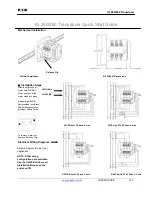
DNT500
2008 by RF Monolithics,
Inc.
5
M-0500-0000 Rev D
The DNT500 provides two ways to switch between transparent and protocol modes. If
CFG input Pin 18 on the DNT500 is switched from logic high to low, protocol mode is
invoked. Or if the ASCII escape sequence “DNT500” is sent (without quotation marks) to
the primary serial input following at least a 20 ms pause in data flow, the DNT500 will
switch to the protocol mode. When input Pin 18 is switched from logic low to high, or an
ExitProtocolMode command is sent to the primary serial input, the DNT500 will switch
to transparent operation. Note that if the escape sequence is used to switch to protocol
mode, the sequence will be transmitted before protocol mode is invoked.
When operating in transparent mode, two configuration parameters control when a
DNT500 radio will send the data in its transmit buffer. The MinPacketLength parameter
sets the minimum number of bytes that must be present in the transmit buffer to trigger a
transmission. The TxTimeout parameter sets the maximum time data in the transmit
buffer will be held before transmitting it, even if the number of data bytes is less than
MinPacketLength. The default value for both the MinPacketLength and the TxTimeout
parameters is zero, so that any bytes that arrive in the DNT500 transmit buffer will be
sent on the next hop. As discussed in Section 2.7.3, it is useful to set these parameters to
non-zero values in point-to-multipoint systems where some or all the remotes are in
transparent mode.
2.3 RF Data Communications
At the beginning of each hop, the base station transmits a synchronizing signal. After the
synchronizing signal has been sent, the base will transmit any user data in its transmit
buffer, unless in transparent mode the MinPacketLength and/or TxTimeout parameters
have been set to non-zero. The maximum amount of user data that the base station can
transmit per hop is limited by the BaseSlotSize parameter, which has a maximum value of
232 bytes. If there is no user data or reception acknowledgements (ACKs) to be sent on a
hop, the base station will only transmit the synchronization signal.
The operation for remotes is similar to the base station, but without the synchronizing
signal. The RemoteSlotSize parameter sets the maximum number of user bytes a remote
can transmit on one hop, up to a limit of 243 bytes per hop. The RemoteSlotSize must be
coordinated with the HopDuration and BaseSlotSize parameters and the number of regis-
tered remotes, as discussed in Section 2.5.3. The MinPacketLength and TxTimeout pa-
rameters operate in a remote in the same manner as in the base station.
2.4 RF Transmission Error Control
The DNT500 supports two error control modes: redundant transmissions and automatic
transmission repeats (ARQ). In both modes, the radio will detect and discard any dupli-
cates of messages it receives so that the host application will only receive one copy of a
given packet. Packet IDs are included in each transmission to allow recipients to identify
if the packet is new or has been received before.
In the redundant transmission mode, packets are repeated a fixed number of times with-
out any acknowledgement (ACK) from the recipient. This error control method is useful
in latency-critical applications such as voice, video and real-time telemetry, where only a










































